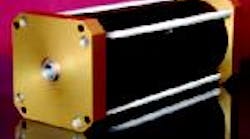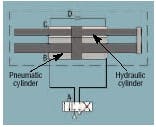Hybrid hydropneumatic actuators hit the industrial market about a year ago. They offer the simplicity and convenience of pneumatic cylinders in combination with the controllability and smoothness of servohydraulics.
Hydropneumatic actuation
Hybrid hydropneumatics present a new class of actuators that harness the power of compressed air but are regulated hydraulically by a built-in, self-contained hydraulic control. The hydraulic control provides the smooth motion typical of hydraulic cylinders. Hydraulic control also gives imparts motion that is free from stiction and chatter; cylinder stops are instant and occur at the moment the air supply is cut off.
The cylinders work from standard compressed air with working pressure ranging from 30 to 300 psi and with standard off-the-shelf pneumatic fittings and valves. Hydropneumatic cylinders are interchangeable with conventional air cylinders and provide a
practical alternative to low-pressure hydraulics.
Three versions of the hybrid actuators have been developed and tested. The basic model has a permanent (pre-set) hydraulic dampening rate. This model was designed to replace conventional actuators in pneumatic systems needing smooth motion, multiple stops throughout the stroke, and better general control by conventional elements of pneumatic logic.
An adjustable model has a builtin valve that allows for manual adjustment of the damping rate. This model was designed to perform functions similar to the functions of the basic model, but with the flexibility of a broad range of speed control.
A hydraulic lock model has a feature that keeps the actuator locked in any position until a control signal to unlock is provided. When the signal is removed, the hydraulic lock returns to the closed position. This model was designed for closed-loop position control systems and other forms of sophisticated and precise control. Hydraulic Lock actuators are designed to be equipped with positional transducers to enable their use in closed-loop position control systems. Laboratory study of such a closed-loop system demonstrated a stable positional accuracy of the actuator of ±0.003 in.
Application heralds success
FEMA Corp., Kalamazoo, Mich., specializes in the design and manufacture of proportional cartridge valves, on-off solenoids, proportional pressure controls, and other electrohydraulic components. During the original installation of their spool pre-press machine, which is used for manufacturing coil assemblies, they used an actuator system combining a pneumatic cylinder with a step motor. The required 4 1 /2-in. stroke and 1,000-lb force demanded a relatively fast stroke from the pneumatics. But the final step — precision pressing of the coil, which required smooth and tightly controlled motion with the same 1,000 lb of force — relied on the step motor.
This system had not produced a satisfactory process, though it was in use for about a year for lack of a better alternative. The two biggest problems described by Tom Snell, an engineer at FEMA, were the explosive action of the pneumatic cylinder and the insufficient force of the step motor. The pneumatic cylinder periodically would overshoot the expected stopping point and land with a hard impact on fixtures and assemblies. This made frequent repairs and adjustments necessary.
The step motor produced only a marginally sufficient force, which periodically caused the machine to put out defective assemblies, which required rework. In general terms, the problem with the original spool prepress machine was inconsistent operation. As articulated by Tom Snell, "It was irritating."
In March 2004, RB Hybrodynamics, Mukilteo, Wash., retrofitted the original actuator system with a single 4-in. bore basic hydropneumatic hybrid cylinder. The hybrid cylinder installed on the original machine without modifications to the frame. This change brought the desired consistency to the process by providing controllable motion, position, and the required force.
Furthermore, the applied force from the hybrid cylinder can be adjusted, making it possible to tailor operation to varying conditions. Consequently, the spool prepress machine now can apply force anywhere from 377 to 1,256 lb, simply by regulating standard shop pressure from 30 to 100 psi.
Benefits include big savings in productivity: less maintenance, less scrap, and less rework. But additional money was saved because the cost of the hybrid cylinder came to about half that of the pneumatic cylinder/stepper motor combination it replaced.
Operation in a nutshell
The novelty of the hydropneumatic actuator is attributed to zero volumetric differential passive hydraulic damping. Zero volumetric differential simply means that the absolute value of the volumetric change of the front hydraulic chamber equals the absolute value of the volumetric change of the rear hydraulic chamber
This information was submitted by Mark Y. Shteynberg, Bureau of Experimental Technologies Corp., Lynnwood, Wash. Contact him at (425) 787-5381, or e-mail betmk@ juno.com.



